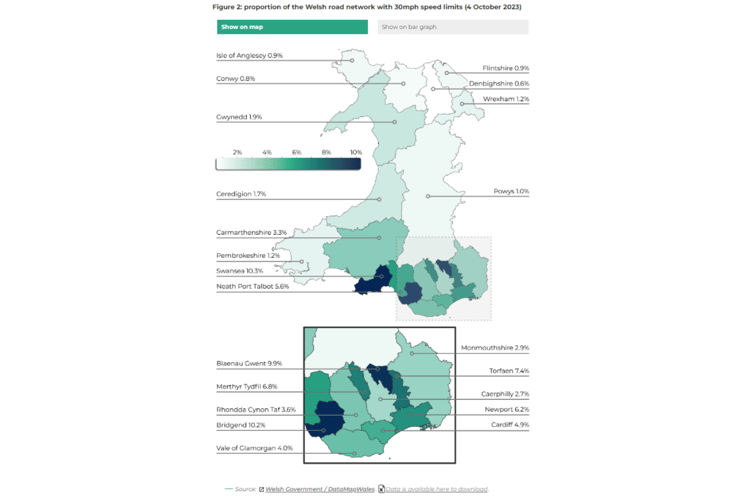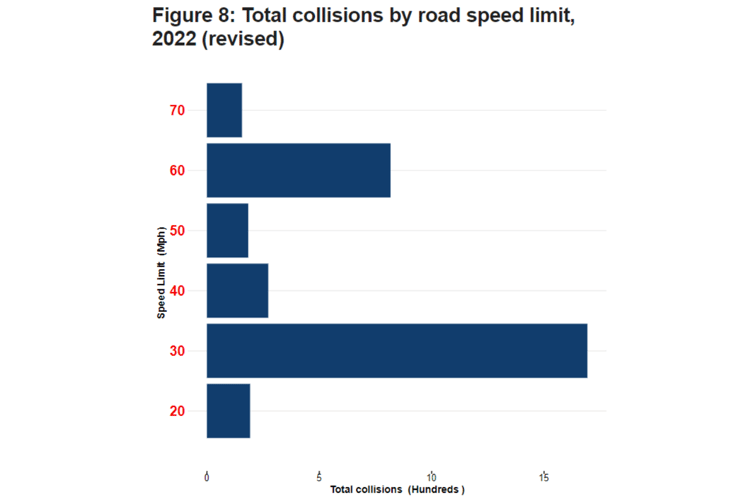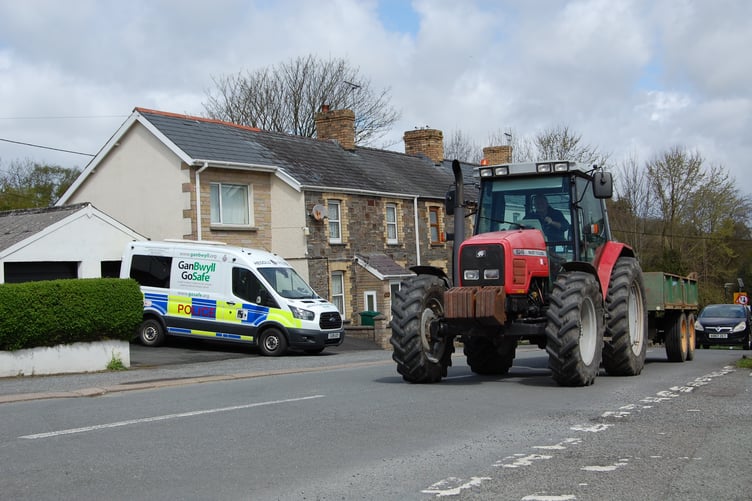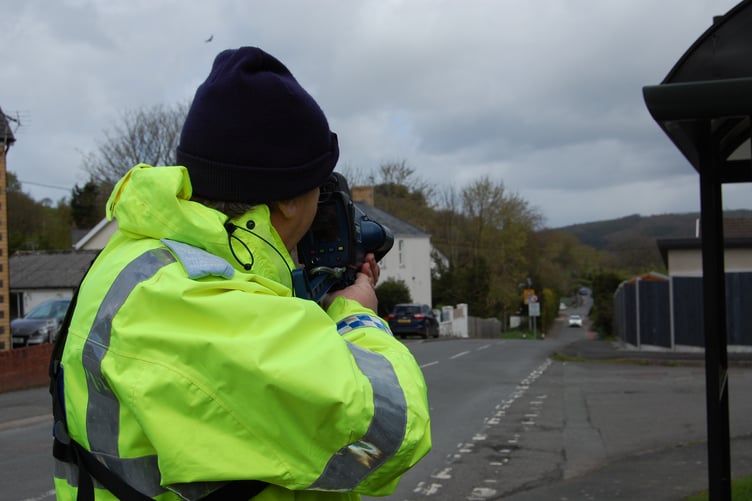Wales is seven months into becoming the first UK country with 20mph default speed limits.
Across the country, threes were changed to twos and drivers' brakes sighed at entering new limit zones.
But it has become more than about just 10mph difference, it has created a culture war where residents have taken up graffitiing in protest or support of the new limits, half a million signed a petition against the new limit- breaking Welsh records for the largest petition in Senedd history, whilst political parties have dubbed the responsible Welsh Labour ‘anti-motorist’.
A speed enforcement officer at a new 20mph speed limit zone in Comins Coch near Aberystwyth
20mph limits grew from covering two per cent of Welsh roads to 37 per cent virtually overnight on 17 September 2023, which the government claims could save Wales lives and improve our health.
Whilst authorities say it’s too early to tell whether the change has caused a drop in collisions, the average speed on 20mph roads has dropped by 4mph since the rollout, from 28.9mph to 24.8mph.
Speeding enforcement for pre-existing 20mph zones (ones that weren’t affected by the Sept change) restarted in November 2023, with Mid and South Wales documenting 1,213 offences from Nov-March with the highest speed recorded at 45mph.
There was however no speed enforcement on new 20mph roads until 18 March.
Since then, North Wales police have recorded eight tickets being issued at one new 20mph location, Glan y Mor Road, Penrhyn Bay.
As part of ‘Operation Ugain’ officers across Wales have been told to focus on engagement and education over fines.
This means those driving above the speed enforcement threshold (guidance is set at 26mph) can be offered a 10-minute presentation at a local centre free of charge instead of a ticket, up to officer discretion.
If the offender accepts, no vehicle or license data will be recorded, pending the offender attending and paying attention to the presentation which focuses on the new limit rules, how to identify the new 20mph areas and why the legislation has been put in place.

However, this may not all be set in stone.
Last week new transport secretary Ken Skates told Senedd a ‘national listening programme’ would take place, approaching businesses and communities about their concerns over the new limit.
MS Skates said the new limit must be ‘truly targetted’, adding: “There is, I believe, a growing consensus in this debate that we can at least build on that 20mph is right around our schools, hospitals, nurseries.”
However, this may not be the right approach.
Citing research from the CAPITALISED petition that drew 469,571 signatures to rescind the 20mph legislation, Belfast is an example that 20mph may not make a material difference to safety.
In 2016, 76 city centre streets in Belfast moved to 20mph, but a 2022 review found ‘little effect for reduction of collisions, casualties and speed’.
But this may not be as true as it seems, with the review adding: “The intervention was implemented at the city centre scale (only 76 streets) in comparison to the recent city-wide intervention in Edinburgh which showed significant reductions in road traffic speed, collisions and casualties.
“Large-scale implementation of 20 mph speed limit interventions may be an important factor for effectiveness.” Edinburgh’s scheme found a 30 per cent decrease in collisions and 31 per cent decrease in casualties in 2021.
A London scheme found similar patterns with a 25 per cent reduction in collisions, and a 24 per cent reduction in death and serious injury in 2022 (it’s unknown how much impact the pandemic had on these figures).
This may cause problems with the efficacy of the Welsh government's 20mph vendetta if it is only applied near schools and hospitals.

Why was the speed limit changed?
There is a host of contradictory reports and data suggesting 20mph limits do or don’t bring significant benefit to public health.
A 2018 Welsh review saw ‘moderate to strong’ evidence of reducing casualties.
However, it’s been consistently found that a person is five to seven times more likely to die if they are hit at 30 compared to 20mph.
The argument from the Welsh government which started down this path in 2019 is that it will save life, save injury, save psychological harm, incentivise more people to walk and cycle and in the long run, save the NHS and wider society money.
Across 2021-2023 a phased roll-out in eight Welsh locations found large positive changes in attitudes to active travel use in built-up areas, seeing a 14 per cent increase in active travel to school.
It documented large positive changes to speed compliance and slight positive changes to average speed and vehicle yielding behaviours to pedestrians.
No difference was found in air quality, with an average ‘marginal increase’ in journey times.
According to police-recorded road collision data for 2022, collisions were by far the most common in 30mph zones, higher than at any other speed limit.

One factor in this could be that pedestrian-heavy areas used to be majority 30mph in Wales.
From the same Welsh government data, driver errors were the three top causes of ‘killed or significant injury’ (KSI) collisions (driver error or reaction, behaviour or inexperience, driver impairment or distraction).
The next most common causes were pedestrian fault, injudicious action by the driver, road environment and driver vision impairment.
According to reporting officers, the top causes for KSI collisions were failure to look, loss of control, careless or in a hurry, failure to judge speed of another party and poor turn/manoeuvre.
Meanwhile, all these behaviours have been anecdotally reported as improved by a slower road environment.
Ann Marie Carty from Artist’s Valley said: “It’s fantastic. It’s easier as a driver as I’ve got more time to react to unexpected things that might appear and I’ve seen more people cross the roads in villages now - they seem much less anxious. It’s hugely better as a cyclist to navigate often narrow village roads when traffic is going much slower.”
Meg Mills from Pantperthog said: “I’m glad about the figures on reduction of pollution, accidents and fatalities, but the thing that’s great for me as a driver, cyclist and mother is how much more relaxed towns and villages feel, from pulling out of junctions, parking and crossing roads with the kids.
“I am so ready for pedestrians - otherwise known as people - to be prioritised over cars. I find the space cars have been given in our towns to be bizarre and unhealthy.”
However for some, the speed limits just don’t make sense.
Lewis (pseudonym), a driver and walker from Machynlleth said: “I can understand the logic of 20mph in areas where people walk- yet the new Machynlleth bridge is 30mph and will soon be 50mph with a walkway and no railing between road and pavement.
“Pedestrians will have nowhere to go if a car loses control it will end really badly- we need barriers at the very least.”
Meanwhile, a 50-year campaign to get Furnace and Eglwysfach’s pavementless villages' 40mph limit changed has led nowhere, despite the recent change in legislation for 30mph roads.
Whilst the government continues to review areas with 20mph limits which ‘don’t make sense’ - like Bow Street’s trunk road now locally dubbed ‘Slow Street’ - some reversals have come to the bafflement of residents.
Pandy Road in Llanbrynmair is a straight but narrow one-track country lane that begins in a 40mph zone off the busy A470. The beginning 0.2 miles of road with no pavement and close fronting houses was changed to a 20mph zone and then abruptly changed back to 30mph in March.
Residents complained of cars ‘hurtling around the corner’ and fearing for pedestrians and animals that live on the road.
Christine Mannion said: “It’s a dangerous walk, no one kept to 20mph and now they have license to go even faster.”
Whilst Sue Dollimore said: “At last some sense is being shown - let’s hope it happens again somewhere.”
Welsh Conservatives agree with people like Sue, and on 17 April brought a motion calling Labour to scrap what they dub their ‘failed transport policies’ - the road building ban and 20mph limits.
Welsh Conservative Shadow Transport Minister, Natasha Asghar MS, said: “Labour Ministers in Cardiff Bay continue to push their anti-motorist agenda, with drivers being forced out of their vehicles through Labour Government policy.
“The people of Wales want to get on with their daily lives, yet Labour’s lack of investment in public transport, road building ban, and 20mph speed limits are preventing them from doing exactly this.
“In the Senedd [we have called on] Welsh Labour Government to end their war on motorists... and to get Wales moving again.”
Going out on the job
Cambrian News went out with GoSafe Wales, the road casualty reduction partnership, and its ‘Road Safety Practitioners’ on a speed enforcement run at Comins Coch through-road, newly 20mph, near the Ysgol Comins Coch Primary School, previously used as a ‘rat run’ to avoid driving through Aberystwyth town. Lucy Davies lives next to the school on the 20mph road and “welcomed” the change but stated: “It definitely needs enforcement- whilst many cars adhere to the limit and give way arrangements, a number do not. It is much quieter I think and cars are much slower by our property.”
The road now has speed bumps, a width restriction and sporadic enforcement teams to help ‘keep residents safe’.
Officer Ron with 20 years under his belt, who can’t be named fully due to public safety concerns, demonstrated the handheld camera and van camera tech used for monitoring speeding on the go (which they only ever do in ‘approved enforcement locations’ and with notice to the public).
GoSafe told the News this tech gives them more freedom in picking enforcement locations than static cameras and aims to be used as a deterrent, targeting times of day with higher pedestrian traffic such as school drop-offs, placing officers with hi-visibility coats and vans, stating that ‘ideally, we won’t catch anyone’.
The most common response they get when they catch someone speeding in a 20mph zone is that the offender thinks it's a 30 zone because there are streetlights. They say that though the logic is sound, drivers now need to ‘see streetlights- think 20’ instead.

Though there has been some anecdotal improvement to Comins Coch’s previous ‘rat-run’, resident Steven Percival suggested it wasn’t the new speed limits or the road bumps that slow down drivers but the “potholes everywhere”.
Many residents shared their support for 20mph limits near schools or elderly facilities, but that other glaring road safety issues are being ignored because of the furore and money going into the legislative change.
Cara from Comins Coch said: “I grew up in Comins and both my children attended Ysgol Comins too.
“I welcome the 20mph limit as hopefully it's now used less as a 'speedy cut through'.
“In my opinion, what hasn't been dealt with that has been needed for the 40 years of my experience at Comins is the death trap of a junction to meet the A487!
“Incredible that in all the additional spending to add cycle tracks and speed calming the access to a village isn't given equal priority!”
One non-serious incident was recorded on the Comins Coch road between 2018-2022, compared to four incidents on the A487 junction into Comins Coch.
Elsewhere in Powys, Llanbrynmair has been peppered with roads collapsing into ravines which have taken “far too long to resolve” according to Cllr Elwyn Vaughan.
Residents have complained for years of the B4518 near Llan having been cordoned off for years due to the road falling into the adjacent river due to BT needing to move poles and cabling, whilst five years of “bickering” and £32m later 30mph roads have changed to 20mph with the supposed reasoning that it will help save lives and money, whilst crucial roads like the B4518 have been left unaddressed.
A similar problem has now occurred on the A470 near Talerddig over winter 2023, whilst Cllr Vaughan has warned won’t be addressed until autumn, though he states “the 20mph discussion is irrelevant to these projects and is merely a red herring”.





Comments
This article has no comments yet. Be the first to leave a comment.